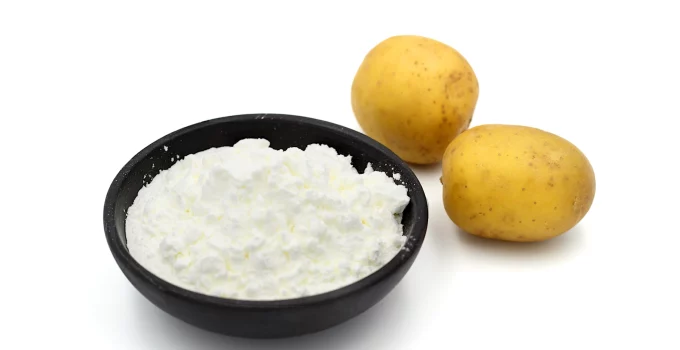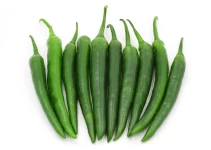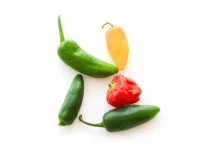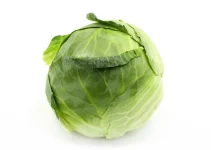I should warn you right from the beginning that the list for potato starch substitutes is a long one.
The good news is that you have plenty of options to choose from if you can’t find potato starch or if you want to use something else instead.
Table of Contents
13 Best Potato Starch Substitutes
Since there are so many substitutes for potato starch, what follows now is quite the long journey but I’m sure you’ll enjoy it and you’ll be able to learn new things.
1. Cornstarch
Let’s start with the substitute that actually has starch in its name. I also believe that cornstarch is one of the easiest to find potato starch substitutes.
It works in a 1:1 substitution.
If the recipe calls for 1 tablespoon potato starch, you can use 1 tablespoon cornstarch instead.
I strongly believe that most of us grew up with it so it’s easy to find in most places around the globe.
It’s also affordable.
Pure cornstarch is a fine, white powder that is obtained from the endosperm of corn, which makes it naturally gluten-free.
Cornstarch has the same uses: thickening agent (soups, sauces, gravies), good for making crispy deep fried food, used for marinating meats to create a velvety texture after they’re stir-fried, for making baked goods.
If you want to quickly make an all-purpose, gluten-free flour mix, you need just 3 ingredients: a gluten-free flour, a gluten-free starch, and xanthan gum/guar gum.
That can be cornstarch, potato starch, tapioca starch, etc.
The flour that has a really good price and can be more easily found is white rice flour. But you can choose other flours if you want.
Moreover, cornstarch is not only a substitute for potato starch but also for the flour made from the same vegetable. It will keep your baking goods moist. It will just lack the creamy color that potato flour offers and that slight hint of potato flavor.
2. Sweet potato starch
I’m sure that there are plenty of you who weren’t aware of such a starch. It definitely doesn’t have the same popularity as other starches (potato, corn, tapioca).
If you’re making naengmyeon, which are Korean soba noodles, you can use potato starch, potato flour, sweet potato starch or even cornstarch.
Moreover, this is a very popular starch used in Sichuan cuisine.
If you want an extra-crispy coating for your fried chicken, this ingredient will help you get that.
If you’re curious about trying it but can’t find it in your local stores, you can make it at home, you’ll find the recipe online.
3. Potato flour
Are potato starch and potato flour the same thing?
Technically, they’re not the same but let’s take one clear example because I consider them to be the same, while others will say that they’re not.
Bob’s Red Mill Potato Flour clearly states on the packaging that it has the same uses that I’ve mentioned above when I described what potato starch is used for.
That’s the best argument for stating that these two potato products are the same, even if they’re made using slightly different processes.
In my introduction of what potato starch is, I mentioned that it’s flour. Naturally we can draw the conclusion that potato starch and potato flour are the same thing.
Some manufacturers will name their products potato flour, while others will write potato starch on the packaging.
The differences
The argument for these two not being the same is that the manufacturing processes are different.
Both are made from raw, whole peeled potatoes. That’s why they’re gluten-free. Some will be organic and pretty much all will mention the words non-GMO.
Potato flour is obtained from whole peeled potatoes that have been cooked, dried, and ground into a very fine, beige-colored flour.
You can use it for thickening, for frying and for baking. That sounds like starch to me.
Potato starch is washed out of crushed potatoes then dried to a fine, bright-wide powder. However, it doesn’t have a potato taste and that’s what really sets the starch apart from the flour and why people say that they’re not the same.
This is pure, flavorless starch but potato flour remains an awesome substitute that can be used in a 1:1 substitution for any recipe. The flour will just add a faint potato flavor and a bit of a creamy color.
4. All-purpose flour/wheat flour
Speaking of flours, can you use regular flour as one of the most accessible potato starch substitutes? Considering that many of us have a bag of normal, plain flour in the pantry, I’m sure that you’re wondering if it works.
It’s not the perfect substitute but it works. You can use bread flour or all purpose flour as long as you don’t follow a gluten-free diet.
White flour also thickens sauces, you just have to use double the amount because the starch absorbs more liquid than plain flour.
Wheat flour should be first mixed with a bit of cold water before being added to the sauce/gravy. Making it liquid prevents it from forming clumps when added to recipes.
If the recipe calls for 1 tablespoon starch, use 2 tablespoons of wheat/bread/all-purpose flour to thicken sauces, soups, and gravies.
Moreover, all-purpose flour is really good for frying meats, too.
If you want to make some crispy fried chicken, you should pick all-purpose flour to serve as a substitute for potato starch.
It works for breading chicken, beef, pork, fish, and other ingredients that you want to deep-fry or pan fry.
Just season your meat or vegetables, drag them through the all purpose flour and then fry them. You can also season the flour to make an even more delicious and flavorful coating.
5. Tapioca flour
Another gluten-free flour that can be used as a substitute is tapioca. It’s extracted from cassava, which is a root vegetable found throughout South America.
The only thing you need to be aware of is that it must be used in a double quantity than the recipe calls for.
If it requires 1 tablespoon potato starch, you should use 2 tablespoons tapioca flour as a substitute.
6. Arrowroot powder/flour/starch
Speaking of South America, arrowroot powder/flour is also made from a plant that it native to Central America, South America, and the West Indies.
And just like tapioca flour, use it in double the quantity required by the recipe.
Whether it goes by the name of powder, flour or starch, all 3 mean the same thing.
It’s a white, powdery starch that’s gluten-free and paleo-friendly.
Some people describe it as a smooth and delicious alternative to cornstarch, which means that it’s a wonderful potato starch substitute, too.
It works for baking, as a thickener and for deep frying/pan frying.
You can use a blend of spices and herbs and then mix them with arrowroot for coating your meats and other ingredients that you want to fry.
The only thing is that I’m not entirely sure that everyone can have easy access to it. Certainly, it’s not as easily available as some of the above suggestions.
7. Rice flour
The good thing about rice flour is that it doesn’t have a taste, just like potato starch.
Moreover, it’s pretty easy to find for most people. And it’s not too expensive.
It works as a gluten-free thickening agent, for making baked goods, and for frying.
How do you use rice flour as a potato starch substitute?
Just use twice as much as the quantity indicated for the starch. It’s the same for tapioca and arrowroot and wheat/all-purpose flour.
You can use hot/cold water to make a paste or in a roux.
8. Ground flaxseed
When mixed with water, ground flaxseed forms a jelly.
By mixing 1 tablespoon of ground flaxseed with 4 tablespoons of water, you’re creating the substitute for 2 tablespoons potato starch.
Check out my reviews for the best flax seed grinders if you want to grind your own.
9. Glucomannan
Those following a low carb diet, will be interested to know that glucomannan is one of the best potato starch substitutes for them.
It’s made from the root of the konjac plant, which means that it contains no calories or carbs. You should also be interested in konjac noodles, which are also made from glucomannan, if that’s the type of food you’re looking for.
Plus, it’s a probiotic. This one certainly sounds like a winner.
What you need to know is that it’s a much more powerful thickener than starch.
You should use 1/4 teaspoon of glucomannan for 2 teaspoons of starch.
Mix it with cold water first because it can turn to clumps quickly when poured into hot liquid.
10. Xanthan gum
When I gave you the description for what roles potato starch plays, I told you that it might remind you of xanthan gum.
Indeed, xanthan gum can be used as a thickening agent, for baking goods, and even for deep-frying. It plays the same roles.
Nevertheless, it’s quite a powerful thickening agent so add a bit at a time and then stir. Add it slowly. If you add too much it might make food turn slimy.
Use it in a 1:1 substitution.
If you don’t like xanthan gum, you can use guar gum, chia seeds, and psyllium husk.
11. Mochi flour (sweet rice flour)
If you’re looking for a potato starch substitute for mochi then use sweet rice flour. It is also known as glutinous rice flour or mochi flour. It’s made from sticky rice.
Even the name suggests that it works as the perfect substitute for this dessert. It also works for other dessert recipes, not only for mochi.
Sweet rice flour has a bit of a sweet flavor, just as the name suggests.
Use it in a 1:1 substitution.
12. Potato starch substitutes for keto diet
Potato starch can occasionally be used even if you’re following a keto diet.
Other than that, you can use: grounded flaxseed, xanthan gum, guar gum, chia seeds, psyllium husk, glucomannan, tapioca.
13. Using cooking techniques as potato starch substitutes
If you want to thicken your recipes naturally, no starch or flours or thickening agents involved, then you’ll have to rely on cooking techniques.
Some of these cooking techniques involve:
simmering (cooking at lower heat for longer)
pureeing leftover veggies can make a sauce thicker
or use sour cream/Greek yogurt to make the sauce creamier and thicker
These cooking techniques also serve as potato starch substitutes but you’re still left with using any of the above replacements for frying or for making baked goods.
What Is Potato Starch Used For?
After talking about all these many potato starch substitutes, let’s see what potato starch is exactly and what it’s used for.
Once you have that figured out, you’ll know exactly which replacements will work best for you and your recipes.
Simply put, potato starch is a gluten-free flour that has one main role: it’s a thickening agent. It’s used for thickening gravies, soups, and sauces.
Moreover, it’s also used in gluten-free cooking and baking.
It attracts and holds water, which means that we can make yeast breads with excellent texture.
In baking, it also provides structure, tenderness and has binding power. It can be used for gluten-free flour mixes, for baking breads, quick breads, muffins.
If you use too much, the baked goods will have a crumbly texture.
I’m pretty sure that description can also remind you of xanthan gum.
One last thing that potato starch is used for is making things crispy, just like cornstarch does. If you want to deep fry food, it’s a great ingredient for coating the ingredients in, for making the batter, because it doesn’t burn at very high temperatures.
It won’t taste like potatoes either.
Potato starch and these potato starch substitutes that I recommended won’t change the flavor of your recipes, their roles are as thickening agents, to provide structure, tenderness, they have binding powers, and can make things crispy when they’re deep-fried.




